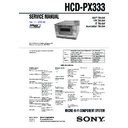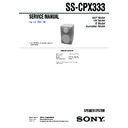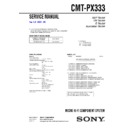Read Sony CMT-PX333 / HCD-PX333 Service Manual online
SERVICE MANUAL
Sony Corporation
Personal Audio Group
Published by Sony Engineering Corporation
HCD-PX333
AEP Model
UK Model
E Model
Australian Model
MICRO HI-FI COMPONENT SYSTEM
9-873-168-02
2005B16-1
© 2005.02
SPECIFICATIONS
Ver. 1.1 2005.02
HCD-PX333 is the Amplifier, CD player, MD
Deck and Tuner section in CMT-PX333.
Deck and Tuner section in CMT-PX333.
Model Name Using Similar Mechanism
HCD-MD595
CD Mechanism Type
CDM55A-21BD53
Base Unit Name
BU-21BD53
Optical Pick-up Name
OP Assy (A-MAX. 2)
Model Name Using Similar Mechanism
HCD-MD595
MD Mechanism Type
MDM-7X2A
Optical Pick-up Name
KMS-262
CD
Section
MD
Section
US and foreign patents licensed from Dolby
Laboratories.
Laboratories.
Amplifier section
European model:
DIN power output (Rated):20 + 20 watts
DIN power output (Rated):20 + 20 watts
(6 ohms at 1 kHz, DIN,
230 V)
230 V)
Continuous RMS power output (Reference):
25 + 25 watts
(6 ohms at 1 kHz,
10% THD, 230 V)
(6 ohms at 1 kHz,
10% THD, 230 V)
Music power output (Reference):
50 + 50 watts
Other models:
DIN power output (Rated):20 + 20 watts (6 ohms at
DIN power output (Rated):20 + 20 watts (6 ohms at
1 kHz, DIN, 240 V)
18 + 18 watts (6 ohms at
1 kHz, DIN, 220 V)
18 + 18 watts (6 ohms at
1 kHz, DIN, 220 V)
Continuous RMS power output (Reference):
25 + 25 watts
(6 ohms at 1 kHz, 10%
THD, 240 V)
23 + 23 watts
(6 ohms at 1 kHz, 10%
THD, 220 V)
(6 ohms at 1 kHz, 10%
THD, 240 V)
23 + 23 watts
(6 ohms at 1 kHz, 10%
THD, 220 V)
Inputs
TAPE IN (phono jacks):
TAPE IN (phono jacks):
voltage 250 mV,
impedance 47 kilohms
impedance 47 kilohms
DIGITAL OPTICAL IN (Supported sampling
frequencies: 32 kHz, 44.1 kHz and 48 kHz)
Outputs
TAPE OUT (phono jacks): voltage 250 mV,
frequencies: 32 kHz, 44.1 kHz and 48 kHz)
Outputs
TAPE OUT (phono jacks): voltage 250 mV,
impedance 1 kilohm
PHONES (stereo minijack):
accepts headphones of
8 ohms or more.
8 ohms or more.
SPEAKER:
accepts impedance of 6 to
16 ohms.
16 ohms.
CD player section
System
Compact disc and digital
audio system
audio system
Laser
Semiconductor laser
(
(
λ=800 nm)
Emission duration:
continuous
continuous
Frequency response
2 Hz – 20 kHz
MD deck section
System
MiniDisc digital audio
system
system
Laser
Semiconductor laser
(
(
λ=780 nm)
Emission duration:
continuous
continuous
Sampling frequency
44.1 kHz
Frequency response
5 Hz – 20 kHz
Tuner section
FM stereo, FM/AM superheterodyne tuner
FM tuner section
Tuning range
FM tuner section
Tuning range
87.5 – 108.0 MHz
(50 kHz step)
(50 kHz step)
Antenna
FM lead antenna
Antenna terminals
75 ohms unbalanced/
300 ohms balanced
300 ohms balanced
Intermediate frequency
10.7 MHz
AM tuner section
Tuning range
European model:
Tuning range
European model:
531 – 1,602 kHz
(with the interval set at
9 kHz)
(with the interval set at
9 kHz)
Other models:
531 – 1,602 kHz
(with the interval set at
9 kHz)
530 – 1,710 kHz
(with the interval set at
10 kHz)
(with the interval set at
9 kHz)
530 – 1,710 kHz
(with the interval set at
10 kHz)
Antenna
AM loop antenna
External antenna terminals
External antenna terminals
Intermediate frequency
450 kHz
General
Power requirements
European model:
European model:
230 V AC, 50/60 Hz
Australian and Hong Kong models:
220 – 240 V AC, 50/60 Hz
Power consumption
European model:
European model:
70 watts
0.8 W or less in standby
mode
0.8 W or less in standby
mode
Other models:
70 watts
Dimensions (w/h/d) incl. projecting parts and controls
Approx. 190
× 141 ×
325 mm
Mass
Approx. 4.9 kg
Design and specifications are subject to change
without notice.
without notice.
2
HCD-PX333
SELF-DIAGNOSIS FUNCTION
The self-diagnosis function consists of error codes for customers, which are displayed automatically when errors occur, and error codes,
which show the error history in the test mode during servicing. For details on how to view error codes for the customer, refer to the following
box in the instruction manual. For details on how to check error codes during servicing, refer to the following “Procedure for using the Self-
Diagnosis Function (Error History Display Mode)”.
which show the error history in the test mode during servicing. For details on how to view error codes for the customer, refer to the following
box in the instruction manual. For details on how to check error codes during servicing, refer to the following “Procedure for using the Self-
Diagnosis Function (Error History Display Mode)”.
MD SECTION
PROCEDURE FOR USING THE SELF-DIAGNOSIS FUNCTION (ERROR HISTORY DISPLAY MODE)
Note 1:
About “R”
As this unit has only a few buttons, some operations require the use of remote commander (RM-S55EM/provided with unit: 1-476-664-21)
buttons. These operations are indicated as “R” in this manual.
Example:
As this unit has only a few buttons, some operations require the use of remote commander (RM-S55EM/provided with unit: 1-476-664-21)
buttons. These operations are indicated as “R” in this manual.
Example:
MENU/NO “R”
...Press the
[MENU/NO]
button of the remote commander.
Note 2:
Incorrect operations may be performed if the MD test mode is not entered properly.
In this case, press the
In this case, press the
?/1
button to turn the power off, and retry to enter the MD test mode.
Note 3:
Perform the self-diagnosis function in the “error history display mode” in the MD test mode. The following describes the least required
procedure. Be careful not to enter other modes by mistake. If you set other modes accidentally, press the
procedure. Be careful not to enter other modes by mistake. If you set other modes accidentally, press the
MENU/NO “R”
button to exit the
mode.
Procedure:
1. Press the
1. Press the
?/1
button to turn the power on.
2. Press the
[FUNCTION]
button to set the MD function.
3. Press three buttons of
M >
TUNING+
,
[REC MODE]
, and
. m
(MD)
simultaneously to enter the MD test mode and display “[Check]”.
4. Press the
.
“R”
or
>
“R”
button to display “[Service]”.
5. Press the
ENTER/YES “R”
button to display “AUTO CHECK”, and press the
>
“R”
button to display “Err Display”.
6. Press the
ENTER/YES “R”
button to enter the error history mode and display “op rec tm”.
7. Select the contents to be displayed or executed using the
.
“R”
or
>
“R”
button.
8. Press the
[CD SYNC NORMAL]
button to light up “IT” indicator, then press the
[REC MODE]
button will display or execute the
contents selected.
9. Press the
[REC MODE]
button another time returns to step 7.
10. Press the
MENU/NO “R”
button displays “Err Display” and release the error history mode.
11. To release the MD test mode, press the
[REPEAT STEREO/MONO]
button to display “Initialize” and release the MD test mode.
Self-diagnosis display
This system has a Self-diagnosis display
function to let you know if there is a system
malfunction. The display shows a code made
up of three letters and a message alternately to
show you the problem. To solve the problem
refer to the following list. If any problem
persists, consult your nearest Sony dealer.
function to let you know if there is a system
malfunction. The display shows a code made
up of three letters and a message alternately to
show you the problem. To solve the problem
refer to the following list. If any problem
persists, consult your nearest Sony dealer.
C11/Protected
The MD is protected against erasure.
t Remove the MD and slide the tab to close the
slot.
C12/Cannot Copy
You tried to record a CD or MD with a format that
the system does not support, such as a CD-ROM.
the system does not support, such as a CD-ROM.
t Remove the disc and turn off the system once,
then turn it on again.
C13/REC Error
Recording could not be performed properly.
t Move the system to a stable place, and start
recording over from the beginning.
The MD is dirty or scratched, or the MD does not
meet the standards.
meet the standards.
t Replace the MD and start recording over from
the beginning.
C13/Read Error
The MD deck cannot read the disc information
properly.
properly.
t Remove the MD once, then insert it again.
C14/Toc Error
The MD deck cannot read the disc information
properly.
properly.
t Replace the MD.
t Erase all the recorded contents of the MD using
t Erase all the recorded contents of the MD using
the All Erase function.
C41/Cannot Copy
The sound source is a copy of a commercially
available music software, or you tried to record a
CD-R (Recordable CD).
available music software, or you tried to record a
CD-R (Recordable CD).
t The Serial Copy Management System prevents
making a digital copy (see page 44). You cannot
record a CD-R.
record a CD-R.
C71/Check OPT-IN
This appears momentarily because of the signal of
the digital broadcast during recording.
the digital broadcast during recording.
t There is no affect on the recorded contents.
No component is connected to the DIGITAL
OPTICAL IN jack, or a digital component is not
connected properly.
OPTICAL IN jack, or a digital component is not
connected properly.
t Connect a digital component to the DIGITAL
OPTICAL IN jack properly using a digital
connecting cable.
connecting cable.
The connected digital component is not turned on.
t See the operating instructions supplied with the
connected component and confirm whether the
component is turned on.
component is turned on.
The digital connecting cable connected to the
DIGITAL OPTICAL IN jack is pulled out, or the
connected digital component is turned off during
digital recording.
DIGITAL OPTICAL IN jack is pulled out, or the
connected digital component is turned off during
digital recording.
t Connect the cable, or turn on the digital
component.
E0001/MEMORY NG
There is an error in the internal data that the system
needs in order to operate.
needs in order to operate.
t Consult your nearest Sony dealer.
E0101/LASER NG
There is a problem with the optical pickup.
t The optical pickup may have failed. Consult your
nearest Sony dealer.
3
HCD-PX333
ITEMS OF ERROR HISTORY MODE ITEMS AND CONTENTS
Display
Details of History
op rec tm
Displays the recording time.
Displayed as “rssmin”.
The displayed time is the total time the laser is set to the high power state.
This is about 1/4 of the actual recording time.
The time is displayed in decimal digits from 0h.
Displayed as “rssmin”.
The displayed time is the total time the laser is set to the high power state.
This is about 1/4 of the actual recording time.
The time is displayed in decimal digits from 0h.
op play tm
Displays the playback time.
Displayed as “pssssssh”. The displayed time is the total of the actual play time.
The time is displayed in hexadecimal digits from 0h.
Displayed as “pssssssh”. The displayed time is the total of the actual play time.
The time is displayed in hexadecimal digits from 0h.
spdl rp tm
Displays the spindle motor running time.
Displayed as “rssssssh”.
The time is displayed in hexadecimal digits from 0h.
Displayed as “rssssssh”.
The time is displayed in hexadecimal digits from 0h.
retry err
Displays the total number of retries during recording and number of retry errors during play.
Displayed as “r ss p ss”.
“r” indicates the retries during recording while “p” indicates the retry errors during play.
The number of retries and retry errors are displayed in hexadecimal digits from 00 to FF.
Displayed as “r ss p ss”.
“r” indicates the retries during recording while “p” indicates the retry errors during play.
The number of retries and retry errors are displayed in hexadecimal digits from 00 to FF.
total err
Displays the total number of errors.
Displayed as “total ss”.
The number of errors is displayed in hexadecimal digits from 00 to FF.
Displayed as “total ss”.
The number of errors is displayed in hexadecimal digits from 00 to FF.
err history
Displays the 10 latest errors.
Displayed as “0s ErrCd @@”.
s indicates the history number. The smaller the number, the more recent is the error. (00 is the latest)
@@ indicates the error code.
Refer to the following table for the details. The error history can be switched by pressing the
Displayed as “0s ErrCd @@”.
s indicates the history number. The smaller the number, the more recent is the error. (00 is the latest)
@@ indicates the error code.
Refer to the following table for the details. The error history can be switched by pressing the
.
“R”
or
>
“R”
button.
retry adrs
Display the 5 latest retry address.
Display as “ss ADRS@@@@”.
ss indicates the history number. The smaller the number, the more recent is the error. (00 is the latest)
@@@@ indicates the cluster of retry address.
The number of retry address can be switched by pressing the
Display as “ss ADRS@@@@”.
ss indicates the history number. The smaller the number, the more recent is the error. (00 is the latest)
@@@@ indicates the cluster of retry address.
The number of retry address can be switched by pressing the
.
“R”
or
>
“R”
button.
er refresh
Mode to clear the error history and retry address history.
Procedure:
1) Press the
Procedure:
1) Press the
[REC MODE]
button.
2) The display will change to “er refresh?”, and then press the
ENTER/YES “R”
button.
The operation is over if “Complete!” is displayed.
After this mode was executed, check the following:
• The data have been cleared.
• Perform the recording and playing to check that the mechanism operates normally.
After this mode was executed, check the following:
• The data have been cleared.
• Perform the recording and playing to check that the mechanism operates normally.
tm refresh
Mode to clear cumulative time of “op rec tm” and “op play tm”.
Procedure:
1) Press the
Procedure:
1) Press the
[REC MODE]
button.
2) The display will change to “tm refresh?”, and then press the
ENTER/YES “R”
button.
The operation is over if “Complete!” is displayed.
op change
Mode to clear cumulative time of “op rec tm” and “op play tm”.
These historical data are used to determine the timing when the optical pick-up is to be replaced. When the optical
pick-up was replaced, perform this operation to clear historical data.
Procedure:
1) Press the
These historical data are used to determine the timing when the optical pick-up is to be replaced. When the optical
pick-up was replaced, perform this operation to clear historical data.
Procedure:
1) Press the
[REC MODE]
button.
2) The display will change to “op change?”, and then press the
ENTER/YES “R”
button.
The operation is over if “Complete!” is displayed.
spdl change
Mode to clear cumulative time of “spdl rp tm”.
This historical data is used to determine the timing when the spindle motor is to be replaced. When the spindle
motor was replaced,
This historical data is used to determine the timing when the spindle motor is to be replaced. When the spindle
motor was replaced,
perform this operation to clear historical data.
Procedure:
1) Press the
1) Press the
[REC MODE]
button.
2) The display will change to “spdl change?”, and then press the
ENTER/YES “R”
button.
The operation is over if “Complete!” is displayed.
4
HCD-PX333
Error Code
Details of Error
10
Loading failed
12
Loading switch combination is illegal
20
Head of PTOC could not be read within the
specified time
specified time
21
Head of PTOC could be read but its content is
erroneous
erroneous
22
Access to UTOC could not be made within the
specified time
specified time
23
UTOC could be not read within the specified
time
time
24
Content of UTOC is erroneous
30
Playing could not start
31
Content of sector is erroneous
40
Cause of retry occurred during normal
recording
recording
41
D-RAM overflowed and retry was executed
42
Retry was executed during the writing to TOC
43
S.F editing was interrupted by retry
50
Address could not be read except in access
processing
processing
51
Focusing failed and it is out of control
60
Unlock retry
Table of Error Codes



